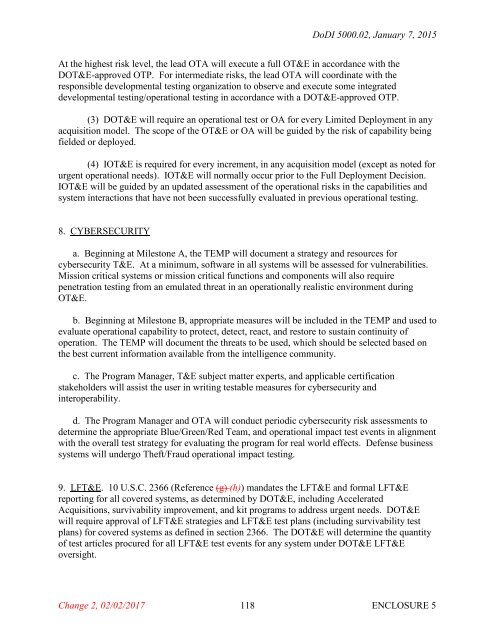Department of Defense INSTRUCTION
x9tnk
x9tnk
You also want an ePaper? Increase the reach of your titles
YUMPU automatically turns print PDFs into web optimized ePapers that Google loves.
DoDI 5000.02, January 7, 2015<br />
At the highest risk level, the lead OTA will execute a full OT&E in accordance with the<br />
DOT&E-approved OTP. For intermediate risks, the lead OTA will coordinate with the<br />
responsible developmental testing organization to observe and execute some integrated<br />
developmental testing/operational testing in accordance with a DOT&E-approved OTP.<br />
(3) DOT&E will require an operational test or OA for every Limited Deployment in any<br />
acquisition model. The scope <strong>of</strong> the OT&E or OA will be guided by the risk <strong>of</strong> capability being<br />
fielded or deployed.<br />
(4) IOT&E is required for every increment, in any acquisition model (except as noted for<br />
urgent operational needs). IOT&E will normally occur prior to the Full Deployment Decision.<br />
IOT&E will be guided by an updated assessment <strong>of</strong> the operational risks in the capabilities and<br />
system interactions that have not been successfully evaluated in previous operational testing.<br />
8. CYBERSECURITY<br />
a. Beginning at Milestone A, the TEMP will document a strategy and resources for<br />
cybersecurity T&E. At a minimum, s<strong>of</strong>tware in all systems will be assessed for vulnerabilities.<br />
Mission critical systems or mission critical functions and components will also require<br />
penetration testing from an emulated threat in an operationally realistic environment during<br />
OT&E.<br />
b. Beginning at Milestone B, appropriate measures will be included in the TEMP and used to<br />
evaluate operational capability to protect, detect, react, and restore to sustain continuity <strong>of</strong><br />
operation. The TEMP will document the threats to be used, which should be selected based on<br />
the best current information available from the intelligence community.<br />
c. The Program Manager, T&E subject matter experts, and applicable certification<br />
stakeholders will assist the user in writing testable measures for cybersecurity and<br />
interoperability.<br />
d. The Program Manager and OTA will conduct periodic cybersecurity risk assessments to<br />
determine the appropriate Blue/Green/Red Team, and operational impact test events in alignment<br />
with the overall test strategy for evaluating the program for real world effects. <strong>Defense</strong> business<br />
systems will undergo Theft/Fraud operational impact testing.<br />
9. LFT&E. 10 U.S.C. 2366 (Reference (g) (h)) mandates the LFT&E and formal LFT&E<br />
reporting for all covered systems, as determined by DOT&E, including Accelerated<br />
Acquisitions, survivability improvement, and kit programs to address urgent needs. DOT&E<br />
will require approval <strong>of</strong> LFT&E strategies and LFT&E test plans (including survivability test<br />
plans) for covered systems as defined in section 2366. The DOT&E will determine the quantity<br />
<strong>of</strong> test articles procured for all LFT&E test events for any system under DOT&E LFT&E<br />
oversight.<br />
Change 2, 02/02/2017 118<br />
ENCLOSURE 5


